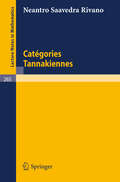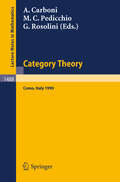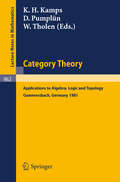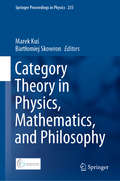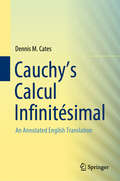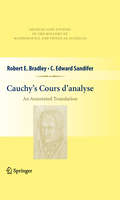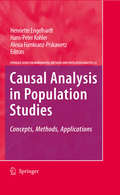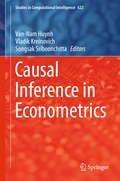- Table View
- List View
Category Seminar: Proceedings Sydney Category Theory Seminar 1972 /1973 (Lecture Notes in Mathematics #420)
by G. M. KellyCategory Theory: Proceedings of the International Conference held in Como, Italy, July 22-28, 1990 (Lecture Notes in Mathematics #1488)
by Aurelio Carboni Maria C. Pedicchio Giuseppe RosoliniWith one exception, these papers are original and fully refereed research articles on various applications of Category Theory to Algebraic Topology, Logic and Computer Science. The exception is an outstanding and lengthy survey paper by Joyal/Street (80 pp) on a growing subject: it gives an account of classical Tannaka duality in such a way as to be accessible to the general mathematical reader, and to provide a key for entry to more recent developments and quantum groups. No expertise in either representation theory or category theory is assumed. Topics such as the Fourier cotransform, Tannaka duality for homogeneous spaces, braided tensor categories, Yang-Baxter operators, Knot invariants and quantum groups are introduced and studies. From the Contents: P.J. Freyd: Algebraically complete categories.- J.M.E. Hyland: First steps in synthetic domain theory.- G. Janelidze, W. Tholen: How algebraic is the change-of-base functor?.- A. Joyal, R. Street: An introduction to Tannaka duality and quantum groups.- A. Joyal, M. Tierney: Strong stacks andclassifying spaces.- A. Kock: Algebras for the partial map classifier monad.- F.W. Lawvere: Intrinsic co-Heyting boundaries and the Leibniz rule in certain toposes.- S.H. Schanuel: Negative sets have Euler characteristic and dimension.-
Category Theory: Applications to Algebra, Logic and Topology. Proceedings of the International Conference Held at Gummersbach, July 6-10, 1981 (Lecture Notes in Mathematics #962)
by K. H. Kamps D. Pumplün W. TholenCategory Theory, Homology Theory and Their Applications. Proceedings of the Conference Held at the Seattle Research Center of the Battelle Memorial Institute, June 24 - July 19, 1968: Volume 1 (Lecture Notes in Mathematics #86)
by P. J. HiltonCategory Theory, Homology Theory and Their Applications. Proceedings of the Conference Held at the Seattle Research Center of the Battelle Memorial Institute, June 24 - July 19, 1968: Volume 2 (Lecture Notes in Mathematics #92)
by P. J. HiltonCategory Theory, Homology Theory and Their Applications. Proceedings of the Conference Held at the Seattle Research of the Battelle Memorial Institute, June 24 - July 19, 1968: Volume 3 (Lecture Notes in Mathematics #99)
by P. J. HiltonCategory Theory in Physics, Mathematics, and Philosophy (Springer Proceedings in Physics #235)
by Marek Kuś Bartłomiej SkowronThe contributions gathered here demonstrate how categorical ontology can provide a basis for linking three important basic sciences: mathematics, physics, and philosophy. Category theory is a new formal ontology that shifts the main focus from objects to processes.The book approaches formal ontology in the original sense put forward by the philosopher Edmund Husserl, namely as a science that deals with entities that can be exemplified in all spheres and domains of reality. It is a dynamic, processual, and non-substantial ontology in which all entities can be treated as transformations, and in which objects are merely the sources and aims of these transformations.Thus, in a rather surprising way, when employed as a formal ontology, category theory can unite seemingly disparate disciplines in contemporary science and the humanities, such as physics, mathematics and philosophy, but also computer and complex systems science.
The Cauchy Method of Residues: Volume 2: Theory and Applications (Mathematics and Its Applications #259)
by Dragoslav S. Mitrinovic J.D. KeckicVolume 1, i. e. the monograph The Cauchy Method of Residues - Theory and Applications published by D. Reidel Publishing Company in 1984 is the only book that covers all known applications of the calculus of residues. They range from the theory of equations, theory of numbers, matrix analysis, evaluation of real definite integrals, summation of finite and infinite series, expansions of functions into infinite series and products, ordinary and partial differential equations, mathematical and theoretical physics, to the calculus of finite differences and difference equations. The appearance of Volume 1 was acknowledged by the mathematical community. Favourable reviews and many private communications encouraged the authors to continue their work, the result being the present book, Volume 2, a sequel to Volume 1. We mention that Volume 1 is a revised, extended and updated translation of the book Cauchyjev raeun ostataka sa primenama published in Serbian by Nau~na knjiga, Belgrade in 1978, whereas the greater part of Volume 2 is based upon the second Serbian edition of the mentioned book from 1991. Chapter 1 is introductory while Chapters 2 - 6 are supplements to the corresponding chapters of Volume 1. They mainly contain results missed during the preparation of Volume 1 and also some new results published after 1982. Besides, certain topics which were only briefly mentioned in Volume 1 are treated here in more detail.
Cauchy Problem for Differential Operators with Double Characteristics: Non-Effectively Hyperbolic Characteristics (Lecture Notes in Mathematics #2202)
by Tatsuo NishitaniCombining geometrical and microlocal tools, this monograph gives detailed proofs of many well/ill-posed results related to the Cauchy problem for differential operators with non-effectively hyperbolic double characteristics. Previously scattered over numerous different publications, the results are presented from the viewpoint that the Hamilton map and the geometry of bicharacteristics completely characterizes the well/ill-posedness of the Cauchy problem.A doubly characteristic point of a differential operator P of order m (i.e. one where Pm = dPm = 0) is effectively hyperbolic if the Hamilton map FPm has real non-zero eigen values. When the characteristics are at most double and every double characteristic is effectively hyperbolic, the Cauchy problem for P can be solved for arbitrary lower order terms.If there is a non-effectively hyperbolic characteristic, solvability requires the subprincipal symbol of P to lie between −Pµj and Pµj , where iµj are the positive imaginary eigenvalues of FPm . Moreover, if 0 is an eigenvalue of FPm with corresponding 4 × 4 Jordan block, the spectral structure of FPm is insufficient to determine whether the Cauchy problem is well-posed and the behavior of bicharacteristics near the doubly characteristic manifold plays a crucial role.
The Cauchy Problem for Higher Order Abstract Differential Equations (Lecture Notes in Mathematics #1701)
by Ti-Jun Xiao Jin LiangThe main purpose of this book is to present the basic theory and some recent de velopments concerning the Cauchy problem for higher order abstract differential equations u(n)(t) + ~ AiU(i)(t) = 0, t ~ 0, { U(k)(O) = Uk, 0 ~ k ~ n-l. where AQ, Ab . . . , A - are linear operators in a topological vector space E. n 1 Many problems in nature can be modeled as (ACP ). For example, many n initial value or initial-boundary value problems for partial differential equations, stemmed from mechanics, physics, engineering, control theory, etc. , can be trans lated into this form by regarding the partial differential operators in the space variables as operators Ai (0 ~ i ~ n - 1) in some function space E and letting the boundary conditions (if any) be absorbed into the definition of the space E or of the domain of Ai (this idea of treating initial value or initial-boundary value problems was discovered independently by E. Hille and K. Yosida in the forties). The theory of (ACP ) is closely connected with many other branches of n mathematics. Therefore, the study of (ACPn) is important for both theoretical investigations and practical applications. Over the past half a century, (ACP ) has been studied extensively.
The Cauchy-Riemann Complex: Integral Formulae and Neumann Problem (Aspects of Mathematics #34)
by Ingo Lieb Joachim MichelThe method of integral representations is developed in order to establish 1. classical fundamental results of complex analysis both elementary and advanced, 2. subtle existence and regularity theorems for the Cauchy-Riemann equations on complex manifolds.
The Cauchy Transform, Potential Theory and Conformal Mapping
by Steven R. BellThe Cauchy Transform, Potential Theory and Conformal Mapping explores the most central result in all of classical function theory, the Cauchy integral formula, in a new and novel way based on an advance made by Kerzman and Stein in 1976.The book provides a fast track to understanding the Riemann Mapping Theorem. The Dirichlet and Neumann problems f
Cauchy's Calcul Infinitésimal: An Annotated English Translation
by Dennis M. CatesThis book is a complete English translation of Augustin-Louis Cauchy's historic 1823 text (his first devoted to calculus), Résumé des leçons sur le calcul infinitésimal, "Summary of Lectures on the Infinitesimal Calculus," originally written to benefit his École Polytechnique students in Paris. Within this single text, Cauchy succinctly lays out and rigorously develops all of the topics one encounters in an introductory study of the calculus, from his classic definition of the limit to his detailed analysis of the convergence properties of infinite series. In between, the reader will find a full treatment of differential and integral calculus, including the main theorems of calculus and detailed methods of differentiating and integrating a wide variety of functions. Real, single variable calculus is the main focus of the text, but Cauchy spends ample time exploring the extension of his rigorous development to include functions of multiple variables as well as complex functions.This translation maintains the same notation and terminology of Cauchy's original work in the hope of delivering as honest and true a Cauchy experience as possible so that the modern reader can experience his work as it may have been like 200 years ago. This book can be used with advantage today by anyone interested in the history of the calculus and analysis. In addition, it will serve as a particularly valuable supplement to a traditional calculus text for those readers who desire a way to create more texture in a conventional calculus class through the introduction of original historical sources.
Cauchy’s Cours d’analyse: An Annotated Translation (Sources and Studies in the History of Mathematics and Physical Sciences)
by Robert E. Bradley C. Edward SandiferIn 1821, Augustin-Louis Cauchy (1789-1857) published a textbook, the Cours d’analyse, to accompany his course in analysis at the Ecole Polytechnique. It is one of the most influential mathematics books ever written. Not only did Cauchy provide a workable definition of limits and a means to make them the basis of a rigorous theory of calculus, but he also revitalized the idea that all mathematics could be set on such rigorous foundations. Today, the quality of a work of mathematics is judged in part on the quality of its rigor, and this standard is largely due to the transformation brought about by Cauchy and the Cours d’analyse. For this translation, the authors have also added commentary, notes, references, and an index.
Caught by Disorder: Bound States in Random Media (Progress in Mathematical Physics #20)
by Peter StollmannDisorder is one of the predominant topics in science today. The present text is devoted to the mathematical studyofsome particular cases ofdisordered systems. It deals with waves in disordered media. To understand the significance of the influence of disorder, let us start by describing the propagation of waves in a sufficiently ordered or regular environment. That they do in fact propagate is a basic experience that is verified by our senses; we hear sound (acoustic waves) see (electromagnetic waves) and use the fact that electromagnetic waves travel long distances in many aspects ofour daily lives. The discovery that disorder can suppress the transport properties of a medium is oneof the fundamental findings of physics. In its most prominent practical application, the semiconductor, it has revolutionized the technical progress in the past century. A lot of what we see in the world today depends on that relatively young device. The basic phenomenon of wave propagation in disordered media is called a metal-insulator transition: a disordered medium can exhibit good transport prop erties for waves ofrelatively high energy (like a metal) and suppress the propaga tion of waves of low energy (like an insulator). Here we are actually talking about quantum mechanical wave functions that are used to describe electronic transport properties. To give an initial idea of why such a phenomenon could occur, we have to recall that in physical theories waves are represented by solutions to certain partial differential equations. These equations link time derivatives to spatial derivatives.
Causal Analysis in Population Studies: Concepts, Methods, Applications (The Springer Series on Demographic Methods and Population Analysis #23)
by Henriette Engelhardt Hans-Peter Kohler Alexia Fürnkranz-PrskawetzThe central aim of many studies in population research and demography is to explain cause-effect relationships among variables or events. For decades, population scientists have concentrated their efforts on estimating the ‘causes of effects’ by applying standard cross-sectional and dynamic regression techniques, with regression coefficients routinely being understood as estimates of causal effects. The standard approach to infer the ‘effects of causes’ in natural sciences and in psychology is to conduct randomized experiments. In population studies, experimental designs are generally infeasible. In population studies, most research is based on non-experimental designs (observational or survey designs) and rarely on quasi experiments or natural experiments. Using non-experimental designs to infer causal relationships—i.e. relationships that can ultimately inform policies or interventions—is a complex undertaking. Specifically, treatment effects can be inferred from non-experimental data with a counterfactual approach. In this counterfactual perspective, causal effects are defined as the difference between the potential outcome irrespective of whether or not an individual had received a certain treatment (or experienced a certain cause). The counterfactual approach to estimate effects of causes from quasi-experimental data or from observational studies was first proposed by Rubin in 1974 and further developed by James Heckman and others. This book presents both theoretical contributions and empirical applications of the counterfactual approach to causal inference.
Causal Inference: The Mixtape
by Scott CunninghamAn accessible and contemporary introduction to the methods for determining cause and effect in the social sciences Causal inference encompasses the tools that allow social scientists to determine what causes what. Economists—who generally can’t run controlled experiments to test and validate their hypotheses—apply these tools to observational data to make connections. In a messy world, causal inference is what helps establish the causes and effects of the actions being studied, whether the impact (or lack thereof) of increases in the minimum wage on employment, the effects of early childhood education on incarceration later in life, or the introduction of malaria nets in developing regions on economic growth. Scott Cunningham introduces students and practitioners to the methods necessary to arrive at meaningful answers to the questions of causation, using a range of modeling techniques and coding instructions for both the R and Stata programming languages.
Causal Inference: 6th Pacific Causal Inference Conference, PCIC 2024, Shanghai, China, July 5–6, 2024, Revised Selected Papers (Communications in Computer and Information Science #2200)
by Xiao-Hua Zhou Jinzhu JiaThis book constitutes the revised selected papers of the 6th Pacific Causal Inference Conference, PCIC 2024, held in Shanghai, China, during July 5–6, 2024. The 8 papers included in these proceedings were carefully reviewed and selected from 15 submissions. They aim to promote research and developmental activities in the fields of Causal Inference and Artificial Intelligence.
Causal Inference in Econometrics (Studies in Computational Intelligence #622)
by Van-Nam Huynh Vladik Kreinovich Songsak SriboonchittaThis book is devoted to the analysis of causal inference which is one of the most difficult tasks in data analysis: when two phenomena are observed to be related, it is often difficult to decide whether one of them causally influences the other one, or whether these two phenomena have a common cause. This analysis is the main focus of this volume. To get a good understanding of the causal inference, it is important to have models of economic phenomena which are as accurate as possible. Because of this need, this volume also contains papers that use non-traditional economic models, such as fuzzy models and models obtained by using neural networks and data mining techniques. It also contains papers that apply different econometric models to analyze real-life economic dependencies.
Causal Inference in Pharmaceutical Statistics (Chapman & Hall/CRC Biostatistics Series)
by Yixin FangCausal Inference in Pharmaceutical Statistics introduces the basic concepts and fundamental methods of causal inference relevant to pharmaceutical statistics. This book covers causal thinking for different types of commonly used study designs in the pharmaceutical industry, including but not limited to randomized controlled clinical trials, longitudinal studies, singlearm clinical trials with external controls, and real-world evidence studies. The book starts with the central questions in drug development and licensing, takes the reader through the basic concepts and methods via different study types and through different stages, and concludes with a roadmap to conduct causal inference in clinical studies. The book is intended for clinical statisticians and epidemiologists working in the pharmaceutical industry. It will also be useful to graduate students in statistics, biostatistics, and data science looking to pursue a career in the pharmaceutical industry.Key Features: Causal inference book for clinical statisticians in the pharmaceutical industry Introductory level on the most important concepts and methods Align with FDA and ICH guidance documents Across different stages of clinical studies: plan, design, conduct, analysis, and interpretation Cover a variety of commonly used study designs
Causal Inference in Pharmaceutical Statistics (Chapman & Hall/CRC Biostatistics Series)
by Yixin FangCausal Inference in Pharmaceutical Statistics introduces the basic concepts and fundamental methods of causal inference relevant to pharmaceutical statistics. This book covers causal thinking for different types of commonly used study designs in the pharmaceutical industry, including but not limited to randomized controlled clinical trials, longitudinal studies, singlearm clinical trials with external controls, and real-world evidence studies. The book starts with the central questions in drug development and licensing, takes the reader through the basic concepts and methods via different study types and through different stages, and concludes with a roadmap to conduct causal inference in clinical studies. The book is intended for clinical statisticians and epidemiologists working in the pharmaceutical industry. It will also be useful to graduate students in statistics, biostatistics, and data science looking to pursue a career in the pharmaceutical industry.Key Features: Causal inference book for clinical statisticians in the pharmaceutical industry Introductory level on the most important concepts and methods Align with FDA and ICH guidance documents Across different stages of clinical studies: plan, design, conduct, analysis, and interpretation Cover a variety of commonly used study designs
Causal Inference in Statistics: A Primer
by Judea Pearl Nicholas P. Jewell Madelyn GlymourMany of the concepts and terminology surrounding modern causal inference can be quite intimidating to the novice. Judea Pearl presents a book ideal for beginners in statistics, providing a comprehensive introduction to the field of causality. Examples from classical statistics are presented throughout to demonstrate the need for causality in resolving decision-making dilemmas posed by data. Causal methods are also compared to traditional statistical methods, whilst questions are provided at the end of each section to aid student learning.
Causal Inference in Statistics: A Primer
by Judea Pearl Nicholas P. Jewell Madelyn GlymourMany of the concepts and terminology surrounding modern causal inference can be quite intimidating to the novice. Judea Pearl presents a book ideal for beginners in statistics, providing a comprehensive introduction to the field of causality. Examples from classical statistics are presented throughout to demonstrate the need for causality in resolving decision-making dilemmas posed by data. Causal methods are also compared to traditional statistical methods, whilst questions are provided at the end of each section to aid student learning.
Causal Models and Intelligent Data Management
by Alex GammermanThe need to electronically store, manipulate and analyze large-scale, high-dimensional data sets requires new computational methods. This book presents new intelligent data management methods and tools, including new results from the field of inference. Leading experts also map out future directions of intelligent data analysis. This book will be a valuable reference for researchers exploring the interdisciplinary area between statistics and computer science as well as for professionals applying advanced data analysis methods in industry.
